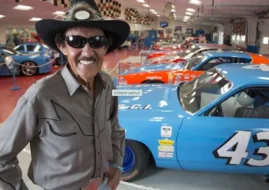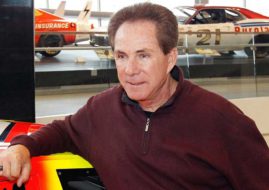Talladega Superspeedway - the Greatest of All American Speedways
For an audience outside the United States, all NASCAR tracks might feel the same: big, high-speed ovals with a capacity to host at least a few hundred thousand spectators. However, there is one specific track that has set the standard for all oval circuits in motorsports, and it’s the Talladega Superspeedway in Alabama.
In the late ’60s, William “Bill” France Sr. (the man behind the NASCAR championship) started thinking of building a new and fast circuit that would outdo the Daytona International Speedway. After some time, he found the perfect position on an old airfield in Talladega in Alabama.

Construction of speedway at Talladega started in May 1968, the track was opened in September 1969
Alabama International Motor Speedway was opened in September 1969
The construction started in May, 1968. The work on the new track took longer than expected and also overshot the initial budget, but France was determined to build a NASCAR circuit like none other. The main engineer was Charles Moneypenny who had previous experience on building the Daytona Speedway, on which he patented the special construction method for high banked ovals.
Finally, in September 1969, the track was completed and it hosted its first-ever race. The official name of the track was Alabama International Motor Speedway, but in 1989, it was changed to Talladega Superspeedway.

The record holder at Talladega Superspeedway is the late Dale Earnhardt with 10 victories in 500 miles races
The 4-miles oval bigger than others
The new circuit was truly unlike anything seen before. For starters, it was bigger and longer with a length of 2.66 miles (4.281 km) and it had three big banks (5 turns) instead of two, like the other circuits did. Secondly, the banking had steeper angles and this helped the drivers to achieve higher speeds.
Initially, the layout proved to be too much for NASCAR cars and driversin the first race, all major drivers had to retire with tire problems since the tire technology at the time was not up to the specifications of the track. However, after a troublesome start, Talladega Superspeedway has since proved to be very popular and has hosted a lot of events. Since 1970, two Sprint Cup 500-miles races were scheduled at Talladega’s raceway every year.
NASCAR Xfinity Series competed at Talladega since 1992, while the Truck Series raced at the Superspeedway in 2006 for first time.

Map: Talladega Superspeedway track layout
Ten wins at Talladega 500-miles races for Dale Earnhardt
The most wins on this track have been made by the late Dale Earnhardt with 10 wins. He scored his first Talladega victory in 1983, and his last one 17 years later. Dale Earnhardt is also the record holder within some other categories: most Top 5s (23 races,), most Top 10s (27 races), and most laps led (1377 laps). It’s interesting that his son Dale Earnhardt Jr. holds the record for most consecutive wins, with four wins between 2001 and 2003 (including wins in both races in 2002).
In total, Dale Earnhardt Jr. took six victories at Talladega raceway, same as Jeff Gordon. Other multiple Sprint Cup winners are Buddy Baker, Darrell Waltrip and Bobby Allison (4 wins), David Pearson, Cale Yarborough, Davey Allison and Brad Keselowski (3 wins), Pete Hamilton, Donnie Allison, Richard Petty, Bill Elliot, Ernie Irvan, Sterling Marlin, Mark Martin, Terry Labonte, Dale Jarrett, Jamie McMurray and Clint Bowyer (2 wins). Multiple winners in other series are Martin Truex Jr., Kyle Busch, Timothy Peters, Todd Bodine, Joey Logano and Joe Nemechek.

Dale Earnhardt and Dale Jr (pictured in 2000) together scored 16 wins at Talladega
Bill Elliott holds the official Talladega Superspeedway NASCAR speed record
Because of its layout, a lot of records were achieved on Talladega. Speeds of over 320 km/h are common on this track but the NASCAR car record is that of 216.3 mph made by Rusty Wallace in 2004. He tested the car without a restrictor plate. Before him, Bill Elliott set the all-time NASCAR qualifying record, winning the pole for the 1987 race at an average speed of 212.8 mph. The record still stands because, since 1988, restrictor plates became obligatory at Talladega.
There were some drivers who were even faster, although with some other types of cars. In 1975, AJ Foyt tested an IndyCar racer with a speed of 217.865 (350.6 km/h). Mark Donohue set a closed-course world record in a Porsche 917-30 at 221.160 mph (355.1 km/h). In 1990, Patty Moise set a record closed-course run for a female at 217.498 mph (350.029 km/h), driving a Buick.

‘The Big Ones’ were very often at Talladega Superspeedway
Indian curse, or just a story
However, with great speeds comes great danger, and unfortunately, Talladega was witness to many tragic racing accidents. The drivers often went airborne and crashed into the fence with sometimes fatal outcomes. But the racing incidents weren’t the only problems that people facedthere were a lot of odd events around the track and people died in car crashes in parking lots, explosions, pit accidents and even helicopter crashes, which fueled rumors of the ‘Talladega curse’.
Legend has it that the track is built on an Indian burial ground and that the native Indians have put a curse on the raceway. The stories began very early and have circulated whenever something bad happened.
In 1973, the famous NASCAR driver Bobby Isaac left his car during the race due to ‘voices’ that he claimed to have heard, which told him to park his car and get out. However, the track legends, famous names, and a possible curse are all part of Talladega enigma explaining why it remains popular even today.
Address: 3366 Speedway Boulevard, Lincoln, Alabama 35096
Ticket information phone: +1 877-462-3342
Official website: www.talladegasuperspeedway.com
Photos: nascar.com, courtneystruth.files.wordpress.com, checkerstowreckers.com, racetickets.com







